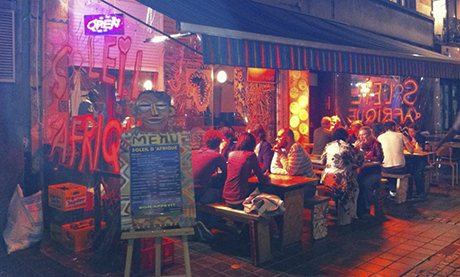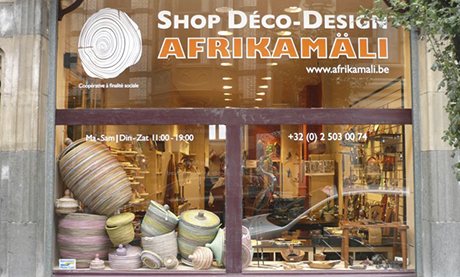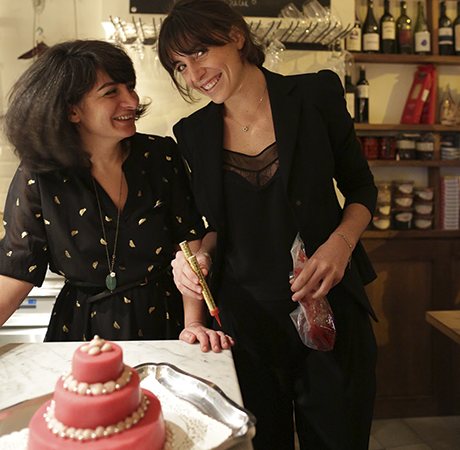“Smile” reads the sign over the ramshackle shopping centre, where racks of highly flammable vest tops rub shoulders with vats of hair relaxer. “You’re in Matonge.”
Tucked incongruously between the plate-glass and concrete of European Union institutions on one side and the high-end boutiques of the Avenue Louise on the other, the African quarter of Brussels hasn’t always had the best reputation. Scruffy and anarchic, it has been a frequent flashpoint for conflict, particularly in 2011 following the Congolese elections, but it’s emerging as one of the most exciting, creative parts of the city.
Named after a lively area of Kinshasa, capital of the Democratic Republic of the Congo, Matonge took shape in the wake of the country’s independence in 1960, though the area already had African associations. The following year, as more Congolese citizens moved to Belgium to study, an aristocratic philanthropist called Monique Van der Straten founded “Maisaf” (La Maison Africaine), a hostel for these students, on rue Alsace-Lorraine, in the heart of today’s Matonge.
A community – with nightclubs, bars and shops – grew up in the network of streets south of Chaussée de Wavre, and other African immigrants followed in the wake of the Congolese pioneers.
At the Kuumba cultural centre, which organises excellent walking tours of the area with local guides, Jeroen Marckelbach explains that, after that first wave of students, Matonge has not been a place where Africans lived (the area has been too expensive for poor migrants for decades), but a meeting place: somewhere to shop, eat and party.

Le Soleil d’Afrique restaurant Photograph: Emma Beddington
Walk down Chaussée de Wavre at night and you’ll see batik shops, hairdressers and exotic grocers all open late, packed with groups of all ages gossiping and hanging out. In the pedestrian rue Longue Vie, restaurants such as Le Soleil d’Afrique serve cheap, delicious chicken mafé, a Senegalese dish with peanut sauce, and dubious cocktails with names like Viagra to customers at packed communal tables, lanyard-draped Eurocrats sitting elbow-to-elbow with Congolese students.
The European Union institutions grew up alongside Matonge, just a few hundred metres to the east but, until recently, the two communities largely kept a cautious distance. Initiatives such as last summer’s Matonge-Europe football tournament, are working to bring them together.
And Matonge has more to offer than wigs, nails and dried fish: it’s a fascinating place to soak up a mix of African culture, bobo (the much-derided bourgeois-bohème) hangouts and historic Brussels.
Afrikamäli – the word means “African treasures” in Swahili – is a community project that set out to show another side to the area: in a bright, appealing shop on rue Ernest Solvay, Magali Sylvestre sells fair traded and ethical crafts from across sub-Saharan Africa, assisted by long-term unemployed locals, for whom the shop is a springboard into work.

Afrikamali shop, Matonge
The central location and relatively forgiving business rents have allowed other small creative entrepreneurs to move in, giving Matonge a more varied texture: places like Le Petit Boudoir, which sells delicate, quirky accessories, or Les Midinettes (30 rue Ernest Solvay, lesmidinettes.be), a sewing atelier, cafe and clothes shop promoting young Belgian designers. There are cavernous vintage shops, second-hand bookstores, cool neighbourhood bars like Stam Café (1 rue Bouré, facebook.com/stam1050) and an excellent art house cinema, the Vendôme.
On the western edge of Matonge, on rue du Berger, is another extraordinary slice of Brussels history. Hôtel le Berger is a former hôtel de rendez-vous, renting rooms by the hour to well-to-do Brussels residents for discreet liaisons. It has kept its louche 1930s charm while adding a few 21st-century comforts.
In the south of Matonge, rue St Boniface is another kind of meeting place, crammed with restaurants and bars, from Japanese ramen to Belgian mussels and all points between. It’s a magnet for young Belgians and expats, and responsible for coaxing a younger, richer public into the area.
From the beautiful Comptoir Florian cafe at number 17, owner Vincent has watched the area evolve. “When I opened 19 years ago, all my friends thought I was mad. There was nothing here. But I knew the area and its history and I loved it. I like how mixed it is.” His customers reflect that: out on the terrace a group of middle-aged African men are laughing over cheesecake, while inside students, galleristas and locals drink Japanese brown rice tea and flick through the piles of interiors magazines.
“Mixed” is a word you hear a lot from the residents of Matonge: that’s a huge part of its appeal. From 78-year-old Bartholomé and his parrot Chirac, still mending shoes on rue de l’Athénée, to the kids checking each other out in the fried chicken shops, all human life is there.

Elisabeth and Sinem of Unico
Looking back over a year since they opened, Elisabeth and Sinem of Unico, a tiny Italian wine bar and restaurant have embraced the area in all its contradictions. “It can seem scary,” says Sinem, “but it’s been wonderful.”
Isabelle and Mathilde of Les Midinettes add a reminder to look up above the bustle and the chaos to discover the wonderful façades and glorious art nouveau details that are everywhere in Matonge’s streets. “Every day, I discover something new” says Isabelle, which would certainly give you something to smile about.
• Eurostar (eurostar.com) trains from London St Pancras to Brussels take under two hours, from £69pp return
//FACEBOOK COMMENT